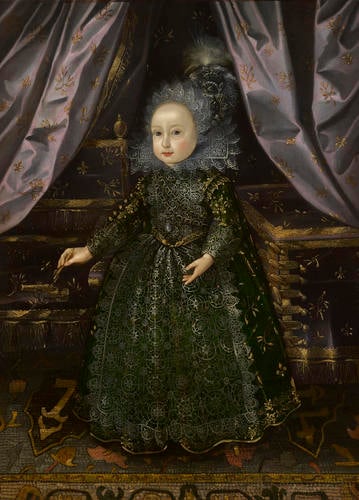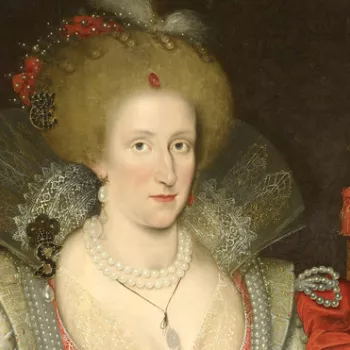Prince Frederick Henry (1614-1629) c.1616
Oil on canvas | 128.5 x 102.2 cm (support, canvas/panel/stretcher external) | RCIN 403511
-
This portrait has traditionally been identified as Henry [Frederick], Prince of Wales (1594-1612), first son of James I, due to the monogrammed HF jewel at the sitter's chest. However the costume, and in particular the style of standing lace collar, suggests a date of c.1616, by which date Prince Henry had already died. A more likely candidate is Henry Frederick, eldest son of Elizabeth of Bohemia, who was born in 1614 and could therefore be around two years old in this portrait. The clothing, jewellery and extraordinary quantity of expensive lace certainly suggest a child of princely status. Henry Frederick is depicted at a slightly older age on the far left in another portrait in the Royal Collection (RCIN 404329).
The prince plays with a toy cannon, while his clothing, and the surrounding upholstery (which interestingly have all been designed to co-ordinate) is woven with olive branches. The two symbols together are perhaps an indication of the princely virtue of ruling wisely through times of both war and peace.Provenance
Probably the Prince of Bohemia sold for £3 to Latham and others on 23 October 1651 from Hampton Court (no 52); recovered at the Restoration and listed in the King's Gallery at Hampton Court in 1666 (no 143); after this the painting is occasionally mentioned at Hampton Court and appears there in Pyne's illustrated Royal Residences of 1819, hanging in the Second Presence Chamber (RCIN 922132).
-
Creator(s)
-
Medium and techniques
Oil on canvas
Measurements
128.5 x 102.2 cm (support, canvas/panel/stretcher external)
140.6 x 115.5 x 6.0 cm (frame, external)
Other number(s)
OM Add-ZanonAlternative title(s)
Henry, Prince of Wales, traditionally identified as
Frederick Henry, Prince of Wales, traditionally identified as
An unknown prince firing a cannon









